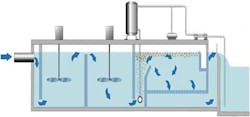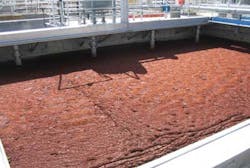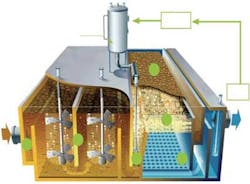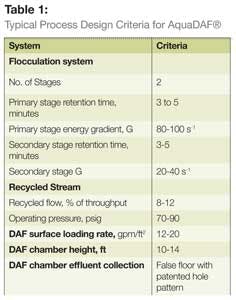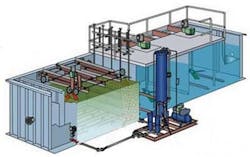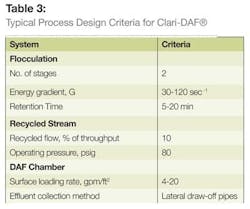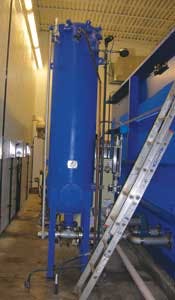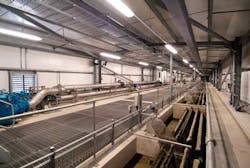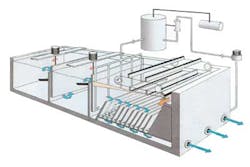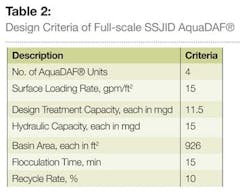Clarifying Treatment: Dissolved Air Flotation Provides Alternative for Treating Raw Water with Light Particles
By Joe Wong
Though dissolved air flotation (DAF) has been used for drinking water clarification in Europe since the late 1960s, it is still somewhat new or unknown to many drinking water treatment professionals in North America. Wastewater treatment professionals, however, do recognize DAF as a well-established sludge thickening process that's also proficient at removing oil and grease from industrial wastewaters.
The first DAF drinking water plant in the U.S. was a 1.2-MGD Krofta DAF system commissioned in Lenox, Mass., in 1982. DAF did not become widespread in the U.S. drinking water industry until the early 2000s with the introduction of high-rate DAF technologies. Since 2000, more than 50 drinking water treatment plants (WTP) in North America have used DAF, with capacities ranging from 0.5 MGD to 290 MGD.
DAF is an alternative clarification process that uses micro air bubbles to attach and float flocculated particles and suspended solids to the water surface for removal (see Fig. 1). In contrast, sedimentation removes settled solids from the bottom.
Before the flocculated water enters the clarification chamber, millions of tiny air bubbles are released from the diffuser nozzles to the water, which attach and float the floc particles to the water surface. The air bubbles are generated in a pumped recycle stream by an air compressor and are dissolved in water through a packed-tower-type of saturator. The floated sludge is removed periodically to a desludging trough, and the clarified water flows to the bottom of the clarifying chamber and then to an effluent control weir for collection. The air saturator is used to dissolve air in the water and then generate bubbles to float the floc particles.
Some of the main advantages of DAF include better performance for removing light particles such as algae, which are difficult to settle. DAF can also usually achieve lower effluent turbidity than settling, typically less than 0.5 NTU. It is not as sensitive to temperature, especially cold temperatures as is common in settling, and the startup time is very short, approximately 30 minutes. Further, DAF does not need to generate heavy floc for settling, so lower coagulant dosage and shorter flocculation time can be used. The process can also operate at much higher surface loading rates (SLR) than sedimentation, especially in the high-rate DAF processes, which can be up to 20 gpm/ft2.
With mechanical sludge removal, the DAF sludge can be quite thick (2 to 5 percent solids), which eliminates the need for thickening before dewatering. Because of air attachment, polymer is not required for stable performance, as opposed to high rate settling processes that must use polymer to attach particles to ballast. Using polymer is a major concern if the clarification process is used for membrane filtration pretreatment. However, DAF is not suited for raw water with high-density solids or turbidities higher than 100 NTU, as the pumped recycle percentage required is higher, making the process more energy intensive and less economical than competing technologies. In general, DAF uses more energy than sedimentation because of the recycle water pumping and air compressing requirements, and it usually needs protection from freezing and raining to prevent the floated solids from settling.
High-Rate Daf Technologies
Traditionally, the SLR of DAF had been in the 4-6 gpm/ft2 range. With the advent of high-rate DAF technologies, which can operate at SLRs of 12-20 gpm/ft2, DAF becomes highly competitive in capital cost and reduces site space requirements, especially at larger treatment plants. Currently, there are three major high-rate DAF technologies - AquaDAF®, Clari-DAF® and Enflo-DAF™. These technologies and their applications are briefly described in this article.
Aqua-DAF
Photo courtesy of Brown and Caldwell.
The Rictor Company developed the AquaDAF system in Finland in the mid-1990s. It is licensed by Infilco Degremont Inc. (IDI) and was introduced to North America in 2000 (see Fig. 2). The process is similar to a generic DAF process, with key differentiators being the slant wall and the orifice plate floor on the bottom of the DAF tank, which improve flow distribution in the separation zone and at the outlet through the plate floor. These features allow the AquaDAF to operate at high SLRs of 12-20 gpm/ft2. Table 1 shows the typical process design criteria of the system.
Since 2000, there have been more than 40 AquaDAF installations throughout the world. The first system in the U.S. was commissioned in 2003 at the 20-MGD Lake DeForest WTP in Nyack, N.Y. Most of the installations were as pretreatment for conventional filters in drinking water treatment; some were as pretreatment for membrane filtration or seawater desalination; and two were for wastewater tertiary treatment. AquaDAF used as pretreatment for desalination systems to combat red tide issues is a growing application worldwide. IDI has also conducted pilot testing in treating spent backwash water from membrane filtration systems.
Clari-DAF
The Clari-DAF system was initially developed in England in the 1990s and was improved by Leopold (a Xylem brand) in the U.S. in the early 2000s (see Fig. 3). The process is similar to a generic DAF process with the main difference being that clarified effluent water is drawn off the bottom of the DAF tank by a series of lateral draw-off pipes that allow for uniform distribution along the bottom of the DAF cell. Thus, the Clari-DAF system can operate at SLRs as high as 20 gpm/ft2. Table 3 shows the typical design criteria for Clari-DAF.
Since the 1990s, more than 40 Clari-DAF plants have been installed globally, with capacities ranging from 0.5 MGD to 108 MGD. Most were installed as pretreatment for conventional filtration, with some for membrane filtration in drinking WTPs. Two installations were for treating spent filter backwash for recycling. Leopold offers different models for different applications, and desalination pretreatment is one of the target markets.
Photo courtesy of Leopold.
Enflo-DAF
Photo courtesy of Enpure Doosan.
The Enflo-DAF process was developed by Enpure, Ltd. (Enpure) of the United Kingdom. It was previously known as DAFRapide in the U.K., and Roberts Filter licensed the process in the U.S. The Enflo-DAF process uses lamella plates, or tubes, in the DAF tank to improve hydraulic flow distribution and increase the separation zone for improved separation of floc-bubble aggregates and free bubbles (see Fig. 4). The resulting SLR can be as high as 20 gpm/ft2. The Enflo-DAF process has a considerable number of installations in Europe and Asia for water treatment but it is still relatively new in North America. However, the nearly-completed 290 MGD Croton WTP in New York City will be using a stacked DAF/filter process similar to the Enflo-Filt™ process. Roberts Filter conducted a successful high-rate Enflo-DAF pilot testing study at Bellingham, Wash. In addition, Robert Filter has recently sold serveral Enflo-DAF systems (10 MGD and under) in the U.S. but these systems are using conventional SLRs (2.4-7.5 gpm/ft2).
After using the 275-MGD Enflo-DAF system from Enpure as pretreatment for the Ras Az Zawr seawater desalination plant in Saudi Arabia, Doosan Heavy Industries (Doosan) bought Enpure in 2012, and the company became Doosan Enpure, Ltd. As Doosan continues to be a major global player in seawater desalination, the use of Enflo-DAF in desalination pretreatment is expected to flourish.
Conclusion
Dissolved air flotation is an alternative clarification process ideal for treating raw water with light particles, such as algae or color-causing organics, and at low temperatures when sedimentation is not as effective. Widely used for drinking water clarification in Europe since the late 1960s, the first DAF system for such application in the U.S. was not installed until 1982. It wasn't until the early 2000s that DAF became more widely used in the U.S. Since that time, DAF has become a mainstream clarification process for drinking water treatment plants, especially where algae is prevalent, as well as a popular pretreatment process for seawater desalination systems to combat red tide or algae bloom occurrences throughout the world.
About the Author: Joseph Wong, P.E., BCEE, is Chief Engineer of Brown and Caldwell with more than 30 years of consulting /engineering experience in industrial and municipal water/wastewater treatment and reuse. He has BS and MS degrees in Chemical Engineering from the University of Washington and is a registered professional engineer in California, Florida and Washington. He developed and designed the world's first major water reuse project in the petrochemical industry using membrane technologies of UF/RO. He is also active in AWWA's Membrane Process, Desalting and Water Treatment Facilities Design and Construction Committees. Currently, he is the committee chair to prepare a new manual M62: Membrane Applications for Water Reuse.
Case Study: South San Joaquin Irrigation District Surface WTP
The design of the Nick C. DeGroot WTP was completed in early 2003, and the plant was dedicated on July 14, 2005. The treatment train included coagulation, flocculation and AquaDAF as pretreatment for removing suspended solids and dissolved materials contributing to color, taste and odor issues; chemical stabilization with lime and carbon dioxide; membrane filtration (ZW-1000) to remove microbial-size and larger particulates; and chlorination (hypochlorite) for disinfection. The design criteria of the full-scale AquaDAF system are presented in Table 2.
The treatment performance of the full-scale AquaDAF system has been similar to that of the pilot plant. The effluent turbidity is approximately 0.5-0.6 NTU, with influent turbidity varying from 1.11-7.17 NTU. The TOC concentrations of the raw water have been higher than those during the pilot testing period and range between 2.0 and 3.1 mg/L. The average TOC removal efficiency of the full-scale AquaDAF has been about 34 percent, which compared well with pilot plant performance. The system has operated well within the SLR of 8-15 gpm/ft2. This 40-MGD WTP is the first membrane filtration plant to use the pretreatment, and it was also the largest membrane plant in California during the time of commissioning. The process is highly compact and provides excellent particulate removal without the use of polymer.
Filter Backwash Treatment
The William R. Oliver WTP in Papillion, Neb., treats an average of 4 MGD with potassium permanganate (KMnO4) and chlorine dioxide (ClO2) to oxidize dissolved manganese. Sternpac coagulant and polymer coagulant help remove solids in the sand-ballasted clarification process. The effluent is processed through eight filters and then stored in a clear well where chlorine disinfectant is added. The filters have an average run time of 20 hours between backwashes and use air/water in their backwash sequence. Since the backwash water was recycled, the plant was required to install a treatment process to prevent potential contaminants from building up in their treatment process. It was decided to install a Clari-DAF BWT (backwash water treatment) system to treat this stream in order to provide maximum protection of public health and optimize the treatment processes.
The Clari-DAF BWT System was designed to handle a maximum flow of 1,310 gpm, with one flocculator to provide 12 minutes of mixing at a loading rate of 7 gpm/ft2 and a recycle rate of 10 percent. Since startup of the unit, the flow has ranged from a low of 400 gpm to a high of 1,000 gpm. Plant personnel have fed Applied Specialties AS-1430PW acrylamide emulsion polymer at 0.2 mg/L. The influent turbidity has been as high as 800 NTU, and the Clari-DAF BWT effluent has been consistently below 1 NTU.
